+ データを開く
データを開く
- 基本情報
基本情報
| 登録情報 | データベース: PDB / ID: 6ybv | ||||||||||||
|---|---|---|---|---|---|---|---|---|---|---|---|---|---|
| タイトル | Structure of a human 48S translational initiation complex - eIF2-TC | ||||||||||||
 要素 要素 |
| ||||||||||||
 キーワード キーワード | TRANSLATION / ribosome / initiation complex | ||||||||||||
| 機能・相同性 |  機能・相同性情報 機能・相同性情報male germ cell proliferation / translation initiation ternary complex / regulation of translation in response to endoplasmic reticulum stress / glial limiting end-foot / HRI-mediated signaling / response to manganese-induced endoplasmic reticulum stress / Cellular response to mitochondrial stress / positive regulation of type B pancreatic cell apoptotic process / Response of EIF2AK1 (HRI) to heme deficiency / Recycling of eIF2:GDP ...male germ cell proliferation / translation initiation ternary complex / regulation of translation in response to endoplasmic reticulum stress / glial limiting end-foot / HRI-mediated signaling / response to manganese-induced endoplasmic reticulum stress / Cellular response to mitochondrial stress / positive regulation of type B pancreatic cell apoptotic process / Response of EIF2AK1 (HRI) to heme deficiency / Recycling of eIF2:GDP / methionyl-initiator methionine tRNA binding / negative regulation of translational initiation in response to stress / PERK-mediated unfolded protein response / PERK regulates gene expression / response to kainic acid / eukaryotic translation initiation factor 2 complex / cytoplasmic translational initiation / regulation of translational initiation in response to stress / translation factor activity, RNA binding / formation of translation preinitiation complex / eukaryotic 48S preinitiation complex / protein-synthesizing GTPase / Formation of the ternary complex, and subsequently, the 43S complex / Ribosomal scanning and start codon recognition / Translation initiation complex formation / Response of EIF2AK4 (GCN2) to amino acid deficiency / GTP hydrolysis and joining of the 60S ribosomal subunit / L13a-mediated translational silencing of Ceruloplasmin expression / mitophagy / translation initiation factor binding / translation initiation factor activity / stress granule assembly / cellular response to amino acid starvation / response to endoplasmic reticulum stress / translational initiation / PKR-mediated signaling / ABC-family proteins mediated transport / male gonad development / cytoplasmic stress granule / cellular response to UV / cellular response to heat / ribosome binding / cellular response to oxidative stress / in utero embryonic development / cadherin binding / mRNA binding / GTPase activity / synapse / GTP binding / mitochondrion / RNA binding / extracellular exosome / zinc ion binding / nucleus / membrane / cytosol / cytoplasm 類似検索 - 分子機能 | ||||||||||||
| 生物種 |  Homo sapiens (ヒト) Homo sapiens (ヒト) | ||||||||||||
| 手法 | 電子顕微鏡法 / 単粒子再構成法 / クライオ電子顕微鏡法 / 解像度: 3.8 Å | ||||||||||||
 データ登録者 データ登録者 | Brito Querido, J. / Sokabe, M. / Kraatz, S. / Gordiyenko, Y. / Skehel, M. / Fraser, C. / Ramakrishnan, V. | ||||||||||||
| 資金援助 |  英国, 英国,  米国, 3件 米国, 3件
| ||||||||||||
 引用 引用 |  ジャーナル: Science / 年: 2020 ジャーナル: Science / 年: 2020タイトル: Structure of a human 48 translational initiation complex. 著者: Jailson Brito Querido / Masaaki Sokabe / Sebastian Kraatz / Yuliya Gordiyenko / J Mark Skehel / Christopher S Fraser / V Ramakrishnan /   要旨: A key step in translational initiation is the recruitment of the 43 preinitiation complex by the cap-binding complex [eukaryotic initiation factor 4F (eIF4F)] at the 5' end of messenger RNA (mRNA) to ...A key step in translational initiation is the recruitment of the 43 preinitiation complex by the cap-binding complex [eukaryotic initiation factor 4F (eIF4F)] at the 5' end of messenger RNA (mRNA) to form the 48 initiation complex (i.e., the 48). The 48 then scans along the mRNA to locate a start codon. To understand the mechanisms involved, we used cryo-electron microscopy to determine the structure of a reconstituted human 48 The structure reveals insights into early events of translation initiation complex assembly, as well as how eIF4F interacts with subunits of eIF3 near the mRNA exit channel in the 43 The location of eIF4F is consistent with a slotting model of mRNA recruitment and suggests that downstream mRNA is unwound at least in part by being "pulled" through the 40 subunit during scanning. | ||||||||||||
| 履歴 |
|
- 構造の表示
構造の表示
| ムービー |
 ムービービューア ムービービューア |
|---|---|
| 構造ビューア | 分子:  Molmil Molmil Jmol/JSmol Jmol/JSmol |
- ダウンロードとリンク
ダウンロードとリンク
- ダウンロード
ダウンロード
| PDBx/mmCIF形式 |  6ybv.cif.gz 6ybv.cif.gz | 183.7 KB | 表示 |  PDBx/mmCIF形式 PDBx/mmCIF形式 |
|---|---|---|---|---|
| PDB形式 |  pdb6ybv.ent.gz pdb6ybv.ent.gz | 127.5 KB | 表示 |  PDB形式 PDB形式 |
| PDBx/mmJSON形式 |  6ybv.json.gz 6ybv.json.gz | ツリー表示 |  PDBx/mmJSON形式 PDBx/mmJSON形式 | |
| その他 |  その他のダウンロード その他のダウンロード |
-検証レポート
| 文書・要旨 |  6ybv_validation.pdf.gz 6ybv_validation.pdf.gz | 1.1 MB | 表示 |  wwPDB検証レポート wwPDB検証レポート |
|---|---|---|---|---|
| 文書・詳細版 |  6ybv_full_validation.pdf.gz 6ybv_full_validation.pdf.gz | 1.1 MB | 表示 | |
| XML形式データ |  6ybv_validation.xml.gz 6ybv_validation.xml.gz | 45.2 KB | 表示 | |
| CIF形式データ |  6ybv_validation.cif.gz 6ybv_validation.cif.gz | 68.5 KB | 表示 | |
| アーカイブディレクトリ |  https://data.pdbj.org/pub/pdb/validation_reports/yb/6ybv https://data.pdbj.org/pub/pdb/validation_reports/yb/6ybv ftp://data.pdbj.org/pub/pdb/validation_reports/yb/6ybv ftp://data.pdbj.org/pub/pdb/validation_reports/yb/6ybv | HTTPS FTP |
-関連構造データ
- リンク
リンク
- 集合体
集合体
| 登録構造単位 | 
|
|---|---|
| 1 |
|
- 要素
要素
| #1: タンパク質 | 分子量: 38454.484 Da / 分子数: 1 / 由来タイプ: 天然 / 由来: (天然)  Homo sapiens (ヒト) / 参照: UniProt: P20042 Homo sapiens (ヒト) / 参照: UniProt: P20042 |
|---|---|
| #2: タンパク質 | 分子量: 36161.180 Da / 分子数: 1 / 由来タイプ: 天然 / 由来: (天然)  Homo sapiens (ヒト) / 参照: UniProt: P05198 Homo sapiens (ヒト) / 参照: UniProt: P05198 |
| #3: RNA鎖 | 分子量: 24231.510 Da / 分子数: 1 / 由来タイプ: 天然 / 由来: (天然)  Homo sapiens (ヒト) / 参照: GenBank: 174924 Homo sapiens (ヒト) / 参照: GenBank: 174924 |
| #4: RNA鎖 | 分子量: 942.660 Da / 分子数: 1 / 由来タイプ: 合成 / 由来: (合成)  Homo sapiens (ヒト) Homo sapiens (ヒト) |
| #5: タンパク質 | 分子量: 51178.406 Da / 分子数: 1 / 由来タイプ: 天然 / 由来: (天然)  Homo sapiens (ヒト) / 参照: UniProt: P41091, protein-synthesizing GTPase Homo sapiens (ヒト) / 参照: UniProt: P41091, protein-synthesizing GTPase |
-実験情報
-実験
| 実験 | 手法: 電子顕微鏡法 |
|---|---|
| EM実験 | 試料の集合状態: PARTICLE / 3次元再構成法: 単粒子再構成法 |
- 試料調製
試料調製
| 構成要素 | 名称: 48S initiation complex / タイプ: RIBOSOME / Entity ID: all / 由来: NATURAL |
|---|---|
| 由来(天然) | 生物種:  Homo sapiens (ヒト) Homo sapiens (ヒト) |
| 緩衝液 | pH: 7.4 |
| 試料 | 包埋: NO / シャドウイング: NO / 染色: NO / 凍結: YES |
| 急速凍結 | 装置: FEI VITROBOT MARK IV / 凍結剤: ETHANE / 湿度: 100 % |
- 電子顕微鏡撮影
電子顕微鏡撮影
| 実験機器 |  モデル: Titan Krios / 画像提供: FEI Company |
|---|---|
| 顕微鏡 | モデル: FEI TITAN KRIOS |
| 電子銃 | 電子線源:  FIELD EMISSION GUN / 加速電圧: 300 kV / 照射モード: FLOOD BEAM FIELD EMISSION GUN / 加速電圧: 300 kV / 照射モード: FLOOD BEAM |
| 電子レンズ | モード: BRIGHT FIELD |
| 撮影 | 平均露光時間: 1 sec. / 電子線照射量: 107 e/Å2 / 検出モード: INTEGRATING フィルム・検出器のモデル: FEI FALCON III (4k x 4k) |
- 解析
解析
| ソフトウェア |
| ||||||||||||||||||||||||
|---|---|---|---|---|---|---|---|---|---|---|---|---|---|---|---|---|---|---|---|---|---|---|---|---|---|
| CTF補正 | タイプ: PHASE FLIPPING AND AMPLITUDE CORRECTION | ||||||||||||||||||||||||
| 3次元再構成 | 解像度: 3.8 Å / 解像度の算出法: FSC 0.143 CUT-OFF / 粒子像の数: 33706 / 対称性のタイプ: POINT | ||||||||||||||||||||||||
| 精密化 | 交差検証法: NONE 立体化学のターゲット値: GeoStd + Monomer Library + CDL v1.2 | ||||||||||||||||||||||||
| 原子変位パラメータ | Biso mean: 65.17 Å2 | ||||||||||||||||||||||||
| 拘束条件 |
|
 ムービー
ムービー コントローラー
コントローラー














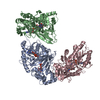


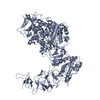
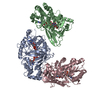
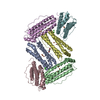
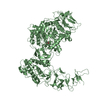
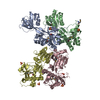

 PDBj
PDBj


































